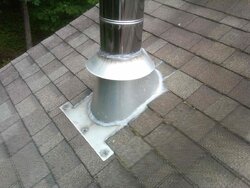I have been putting this off for some time, but it's time to figure out where the water leak is and how some animal is getting into the ceiling box. I didn't put chimney together so Im not sure what side needs to come apart first. Do I take down the outside chimney and romove the roof flange before the inside ceiling box?
Has anyone put one together that can shead some light on this. I think it is dura vent.
Thanks for any help
Tom
Has anyone put one together that can shead some light on this. I think it is dura vent.
Thanks for any help
Tom


